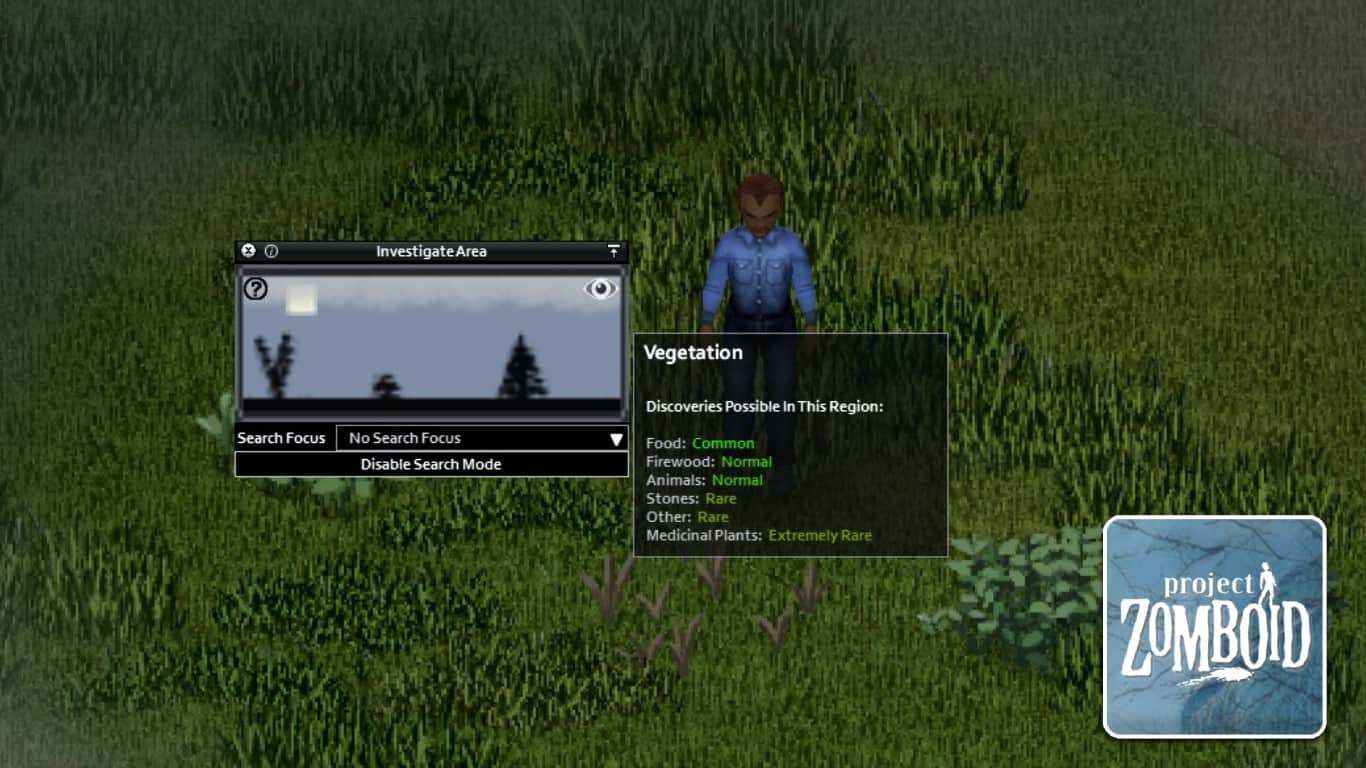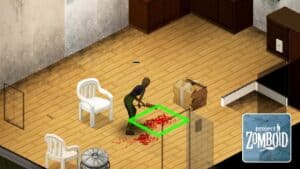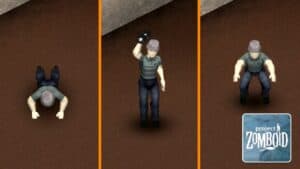Foraging for food and items in Project Zomboid is a vital survival skill that can help you stay as long as possible.
Regardless of what stuff you are looking for, learning how to forage effectively increases the survival rate in the world of zombies.
Read on to learn how to forage for food and items in Project Zomboid.
Recommended Read: How to Know If You Are Infected in Project Zomboid
To forage in Project Zomboid, click on the magnifying glass on the left side of the screen, select “Enable Search Mode”, then walk around and check the area. If an eyeball appears over your head, that means there’s an item you can forage for nearby.
Table of Contents
- How To Forage For Food And Items in Project Zomboid
- Tips & Tricks When Foraging
- Factors Impact Foraging Skill
How To Forage For Food And Items in Project Zomboid
In Project Zomboid, foraging is a simple activity requiring only a little learning time. Here’s how to forage!
The first step is locating the foraging feature on the screen’s left side. Find and click on the Magnifying Glass.
Next, the small panel labeled “Investigate Area” appears.
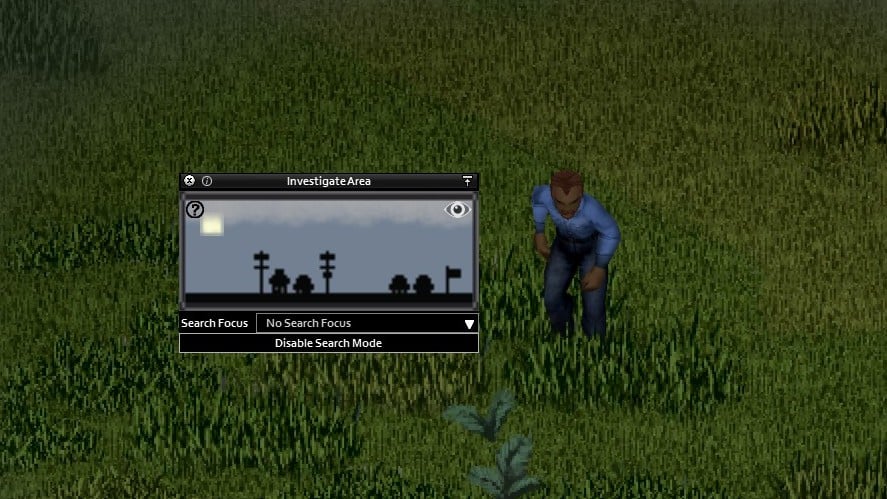
This box will show you what type of area you are currently in. It also tells you how common certain items are based on your location.
Click on “Enable Search Mode” to start foraging.
You’ll notice a “Target Radius” circle around after you enable search mode. This circle will extend when you level up your foraging skill, increasing the probability of finding more food and items.
Once the search mode is enabled, you only have to walk around and search until an eyeball appears over your head.
The eyeball will become more apparent if you stay closer to the food or items.
You can also pay attention to the transparent white arrow on the ground, indicating a nearby item.
When you reach the item, a pop-up window appears over it, revealing its type.
You can double-click on the item’s icon to put it in the inventory.
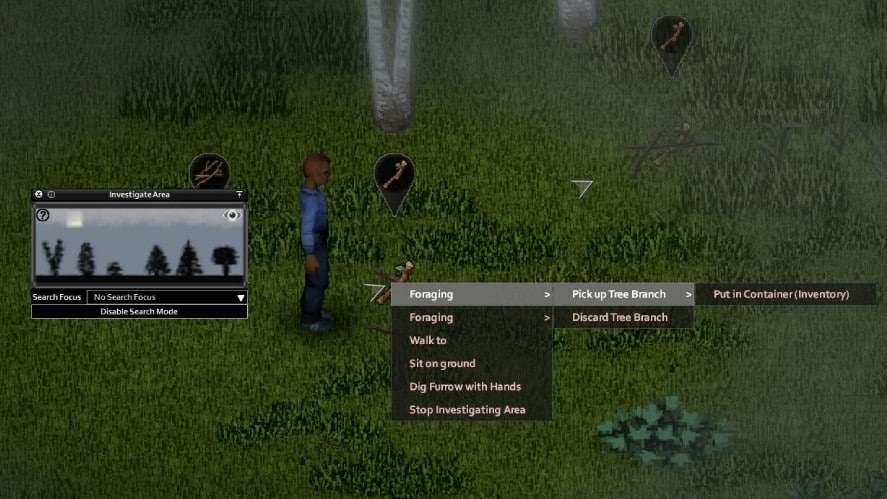
On the other hand, you can right-click on the item, for example, Tree Branch, select “Pick up Tree Branch”, then select “Put in Container (Inventory)”. The right-click option also lets you discard the recently picked item.
No matter what your choice is (pick up or discard), you will gain a little XP after that. The rarer the foraging item is, the more XP you’ll get.
Tips & Tricks When Foraging
The level of foraging skill has its effects on the process.
The higher the level, the more likely you are to spot more items. It also unlocks a search focus, which increases the chance of locating items by category.
Here is the list of items you can find on each level of foraging skill:
- Level 0-1: Junk Items, Berries, Mushrooms, Chipped Stone, Stone, Tree Branch, Twigs, Violets
- Level 2: Wild Vegetables, Grape Leaves, Worms
- Level 3: Wild Onions, Logs
- Level 4: Recipe Magazines, Valuable Junk Items, Cherries, Cricket, and Rosehips
- Level 5: Dead Rat, Oranges
- Level 6: Insects, Jalapenos, Habaneros, Limes, Lemons
- Level 7: Frogs, Dead Birds, Grapes
- Level 8: Dead Squirrels, Strawberries, Pears, Grapefruits, Corn, Eggs & Wild Eggs
- Level 9: Wild Fruit
- Level 10: Dead Rabbits, Wild Fruit
As previously stated, each item will be common in a specific location.
Urban areas are popular for animals and other items. However, materials, food, and medicinal plants are rare here.
The vegetation areas have a common rarity assigned to materials, animals, or food, whereas medicinal plants and other items are rare.

The roads are best for making weapons, as they contain Chipped Stones and Tree Branches.
If you need Twigs or Sticks, we strongly recommend foraging for them in the forests.
Farmlands, vegetation areas, and trailer park areas are the best places to find food, such as Mushrooms, Berries, Junk Food, and Dead Animals.
Other items, like Junk and Medical Supplies, can be found in either urban areas or on roads.
Factors Impact Foraging Skill
Several factors have substantial effects on your foraging activity.

- Foraging Skill: The foraging skill increases the foraging radius by 0.5 squares. The maximum Search Radius is 15 squares.
- Traits: The positive traits, such as Lucky or Former Scout, will add a significant radius modifier to your foraging skill. The negative ones, for instance, Agoraphobic and Short-Sighted, reduce the radius modifier.
- Occupation: Park Ranger increases two points of foraging skill, the Fisherman offers one point, whereas the Fitness Instructor offers 25% for finding junk items.
- Moodles: Moodles have strong effects in extreme cases. For example, hunger adds up to 50% for food items only, whereas panic or stress decreases by up to 95%.
- Movement Type: Aim or sneak movement contributes 33% and 10% to the foraging process. Running or spring will disable the search mode.
- Clothing: The more items that cover your visibility, the less the “Target Radius” circle. For example, wearing items that cover the head, face, and eyes completely decreases by 75% of the search radius.
- Seasons: Some items are only available in a specific period of the year. For instance, Beauty Berries and Holly Berries are special during Fall and Winter. Seasons also offer a higher chance (up to 50%) of availability of items, which means you can find Firewood easily in the Fall.
- Weather and darkness: You’ll find it difficult foraging in rain, snow, or fog conditions, with the maximum effect decreasing by 75% in extreme cases. When the darkness reaches 50%, you can’t spot new items. However, equipping a Lighter or Flashlight in your foraging will remove the darkness effect.
- Nature’s Abundance: The last yet ultimate factor is using the Sandbox setting to control the density of resources in the game. Depending on your setting option, the zone density multipliers will change drastically.
That’s how to forage for food and items in Project Zomboid.
Have any suggestions for this guide? Let us know in the comment section below.

